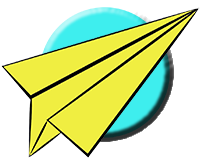Make a Panther Paper Airplane
Make a Panther Paper Airplane
Instructions
1. Use a medium to heavy weight sheet of letter size paper. Fold the paper along the long edge. Leave about one finger width at the bottom edge.
2. Fold the paper left point down so the left edge of the paper lines up with the bottom edge of the top layer. Unfold after the crease has been made.
3. Fold the upper right point down so the right edge of the paper lines up with the bottom edge of the top layer. Unfold after the crease has been made.
4. Unfold the paper and lay it flat on the working surface.
5. Pop the left and right horizontal creases up, bringing the points at the ends of the creases in and down towards the center of the paper. Press the fold down and flat.
6. Fold the topmost layer back so the edges at the top of the paper line up. At the same time bring the points at the left and right edges up and in toward the middle of the paper. Two new creases are formed on each side.
7. Fold the bottom point of the lower triangle up so it hits the top point of the upper triangle. Fold about the existing crease between the two triangles. Two new creases are created as the fold is pressed flat.
8. Fold the bottom point of the lower triangle up so it hits the upper triangle. Fold about the existing crease between the two triangles. Two new creases are created as the fold is pressed flat.
9. Fold down the upper left point which was previously folded up. This creates a new crease in the top-most layer
10. Same thing on the right. Fold down the upper right point which was previously folded up. This again creates a new crease in the top-most layer.
11. Fold the top layer on the nose down so the top edge hits the creases between the two triangles.
12. Fold the layer at the very top of the nose down over the top of the previous fold. The folded edge comes down on the top of the previous fold about halfway down.
13. Flip the paper over so all the flaps are underneath and orient with the long edge to the right
14. Fold the plane exactly in half. Make sure the wing flaps are lined up for good balance.
15. Flip the plane over again so the nose is to the left and the central crease is at the top.
16. Make a crease for the first wing flap. The right point of the crease should be at the base of the fuselage and the left point should be about one half way down the left most edge.
17. Flip the plane over so the first wing flap is underneath and the nose points to the left.
18. Make a crease for the second wing flap. Be sure to line up the wing flaps for good balance.
19. Fold down the top wing flap. The left point of the crease should be less than half way up from the bottom edge of the fuselage and the right point should be perpendicular to the right edge.
20. Flip the plane over again so the first wing flap is underneath and the nose points to the left.
21. Make a crease for the second wing flap. Be sure to line up the wing flaps for good balance.
22. Open up the wing flaps and adjust the wing angles so they are even. Adjust the dihedral angle so that the wings are flat or slightly down. If the dihedral angle is up the plane may fly wildly or even upside down.
THE THROW Make sure the wings are flat or slightly down in angle. Launch gently from a high place for long gliding flights. It the craft is not exactly the same on both sides it will tend to always turn in the same direction. Twist the wing tips a little to adjust for this.
